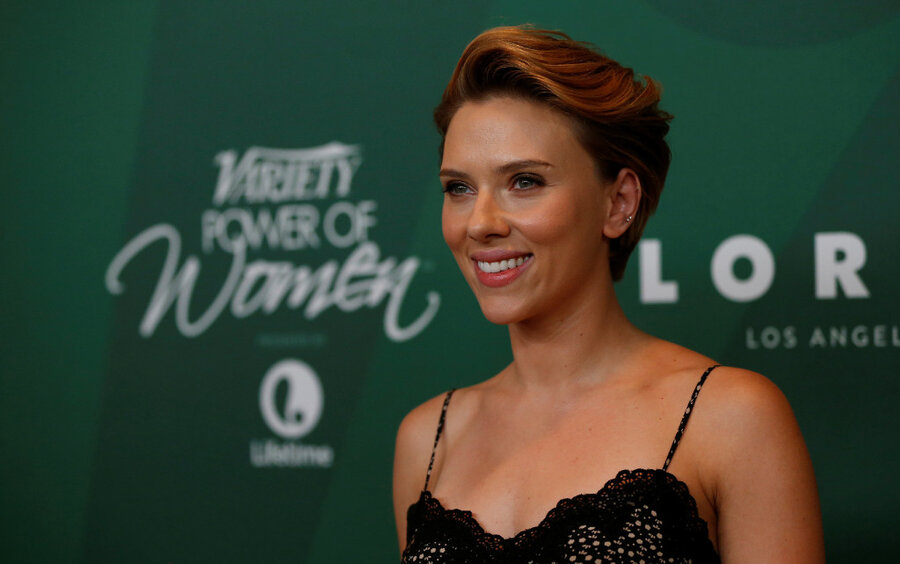Scarlett Johansson: 2016's biggest box office draw, but women still paid less
Loading...
This year’s highest-grossing actor was a woman, but many of the industry’s top paychecks are still falling into the hands of men.
Scarlett Johansson topped 2016’s list of high-grossing actors, with her films raking in $1.2 billion at ticket booths around the globe. She was closely followed by Chris Evans and Robert Downey Jr., whose movies tied them for second place at $1.15 billion, and Margot Robbie and Amy Adams, whose films grossed just more than $1 billion.
To compile the list, Forbes added up the 2016 global ticket sales of top actors’ films released in 2016, using data from Box Office Mojo as of Tuesday. Animated films were excluded, and only those actors who were top-billed or had the most screen time were included.
But the actors ranked among the top 10 highest grossing stars weren’t necessarily the highest paid: Ms. Johansson didn’t rank among the 10 highest paid actors, a list that was topped by Dwayne Johnson, Jackie Chan, and Matt Damon. That group boasted only two women, Jennifer Lawrence and Melissa McCarthy, highlighting the discrepancies in pay between female and male actors in Hollywood.
The issue of equal pay for women has come to the forefront in politics and society, with advocates highlighting the millions of dollars in losses annually as women continue to make about 80 cents on the dollar compared to men.
In Hollywood, where female actors often pull in hundreds of thousands or millions of dollars each year, the gap has been less evident. But some of Hollywood’s biggest players have shone a light on the disparity, calling on filmmakers and producers to close the gap and set an example for women struggling to earn equal pay in other industries.
Jennifer Lawrence kickstarted the debate last year, taking action in a public essay after she discovered that her male costars made more money than she did for the same films.
“It's hard for me to speak about my experience as a working woman because I can safely say my problems aren't exactly relatable. When the Sony hack happened and I found out how much less I was being paid than the lucky people ... I didn't get mad at Sony. I got mad at myself,” Lawrence explained in the piece for Lena Dunham’s “Lenny” newsletter.
She added: “I failed as a negotiator because I gave up early. I didn't want to keep fighting over millions of dollars that, frankly, due to two franchises, I don't need. (I told you it wasn't relatable, don't hate me).”
Since then, other female actors such as Robyn Wright from “House of Cards” and many time Oscar-nominated Meryl Streep have joined the conversation, hoping that their complaints and successes can reverberate across all income levels to help women working in retail or office jobs to achieve fair pay for equal work as well.
Many hoped the trend would change, at least in California, this year. At the beginning of 2016, a law mandating companies must pay women equal salaries for work that is “substantially similar” to that of men, but not just the same, went into effect.
In September, legislators championed the law’s success, and moved to create additional provisions that would further protect working women and also incorporate people of color into the fold.
Still, workers can’t ask for what they don’t know they’re missing, and much like Ms. Lawrence, women often don’t know if their paycheck is smaller than the men who work alongside them.
“There’s still a lot of fear out there, still a lot of taboo about talking about pay,” Jennifer Reisch, legal director for the San Francisco group Equal Rights Advocates, told the Los Angeles Times in September. “It’s very difficult for a single person acting all by herself to discover that she’s being paid less and do something about it.”
The two Forbes lists showed other discrepancies, with only Ben Affleck appearing on both. That could mean there’s an overall gap between how well a movie does at the box office and how much the films’ actors are paid, but the stark contrast between high-earning men and women remains.
Some actresses, such as Emma Stone, say they’ve received equal pay for projects, but note that the industry has yet to become a reliable source for equality among men and women.
“I've been lucky enough to have equal pay to my male costars,” she commented before correcting herself. “Not 'lucky.' I've had pay equal to my male costars in the past few films.” she in a recent interview with Vogue. “But our industry ebbs and flows in a way that's like, 'How much are you bringing into the box office?' 'How much are you the draw or is the other person the draw?' ”
For these actresses, equal pay isn’t about adding more millions to their hefty bank accounts, but about garnering respect and highlighting the ways in which inequality persists, and they’re taking their case to public platforms.
“To every woman who gave birth to every taxpayer and citizen of this nation, we have fought for everybody else’s equal rights,” Patricia Arquette, who won the Oscar for Best Supporting Actress, said in her acceptance speech last year. “It’s our time to have wage equality once and for all, and equal rights for women in the United States of America.”








